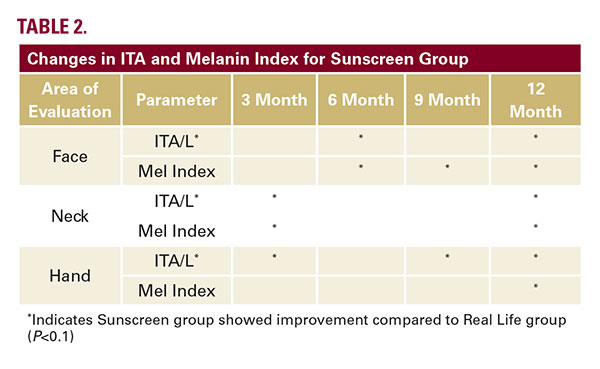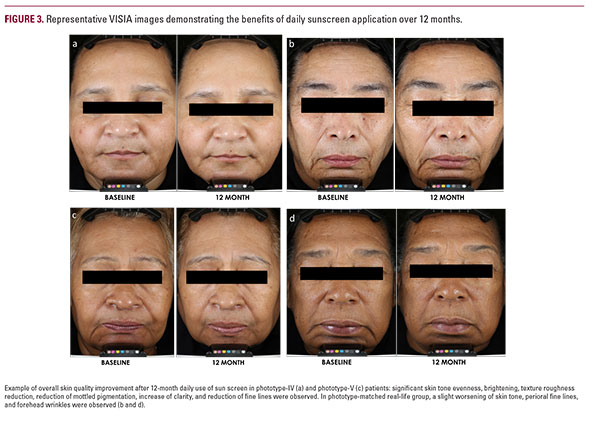Instrumental Evaluation of Skin Color and Melanin Index over 12 Months
Objective measurement of color and melanin levels in long-term clinical studies is challenging, due to many factors including skin color and undertone variability, seasonality impact on skin, and external light conditions. Skin of color patients tend to have higher heterogeneity on facial skin thus increase the complexity of accurately measurement. Del Bino and Bernard reported on the effectiveness of using Individual Typology Angle measurements based on Chromameter L*a*b values and the melanin index recorded with a Mexameter, and good correlation between these two instruments.21
In the current study, both Chromameter ITA/L* and Mexameter melanin index were investigated at baseline, 3, 6, 9, and 12 months. Both instruments gave similar measurement trends as observed in previous studies. Seasonal impact on skin color and high variability among individuals were observed, as expected. An increase of skin brightness and reduction of melanin content in skin were observed over time with daily sunscreen when compared to the real life group. The effect was most apparent at 12 months (Table 2). These findings support the clinical grading results of positive impact by daily application of sunscreen.
Biopsy Analysis
The biopsy samples were evaluated for potential histological changes between the sunscreen and real-life groups at the initiation and the conclusion of the 12-month study. Fontana- Masson staining was used to visualize melanin content of skin (Figure 4), and CD68 was used as a biomarker for Macrophage infiltration (Figure 5). The real-life samples at the 12-month time-point showed a tendency for higher levels of pigmentation incontinence compared to the sunscreen group with visibly increase dermal melanin (Figure 4a-d, P=0.086). Indeed, when


Objective measurement of color and melanin levels in long-term clinical studies is challenging, due to many factors including skin color and undertone variability, seasonality impact on skin, and external light conditions. Skin of color patients tend to have higher heterogeneity on facial skin thus increase the complexity of accurately measurement. Del Bino and Bernard reported on the effectiveness of using Individual Typology Angle measurements based on Chromameter L*a*b values and the melanin index recorded with a Mexameter, and good correlation between these two instruments.21
In the current study, both Chromameter ITA/L* and Mexameter melanin index were investigated at baseline, 3, 6, 9, and 12 months. Both instruments gave similar measurement trends as observed in previous studies. Seasonal impact on skin color and high variability among individuals were observed, as expected. An increase of skin brightness and reduction of melanin content in skin were observed over time with daily sunscreen when compared to the real life group. The effect was most apparent at 12 months (Table 2). These findings support the clinical grading results of positive impact by daily application of sunscreen.
Biopsy Analysis
The biopsy samples were evaluated for potential histological changes between the sunscreen and real-life groups at the initiation and the conclusion of the 12-month study. Fontana- Masson staining was used to visualize melanin content of skin (Figure 4), and CD68 was used as a biomarker for Macrophage infiltration (Figure 5). The real-life samples at the 12-month time-point showed a tendency for higher levels of pigmentation incontinence compared to the sunscreen group with visibly increase dermal melanin (Figure 4a-d, P=0.086). Indeed, when








